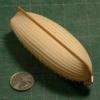-
Posts
13,301 -
Joined
-
Last visited
Content Type
Profiles
Forums
Gallery
Events
Everything posted by druxey
-

Need help with saw blade output
druxey replied to bigcreekdad's topic in Modeling tools and Workshop Equipment
And, unfortunately, I can tell stories of severed digits (not my own - I still have all ten and intend to maintain that number!) -

Need help with saw blade output
druxey replied to bigcreekdad's topic in Modeling tools and Workshop Equipment
Respect is a good attitude to have! -

Need help with saw blade output
druxey replied to bigcreekdad's topic in Modeling tools and Workshop Equipment
I was not being flippant. It's all too easy to have an accident if you aren't well versed in saw usage. From your questions I presumed that you are not that familiar with the subject. I'd rather you were safe than sorry. -

Need help with saw blade output
druxey replied to bigcreekdad's topic in Modeling tools and Workshop Equipment
You might also want to read up on safe techniques when using power saws. -
Usually, as mentioned, the inner end of the boom was drilled with a hole. A length of line, knotted at one end, was passed through this hole, then around the boom and yard several times. The line was then hove tight with several round turns taken between the yard and boom and finished with a couple of half hitches.
-
That fascinating fitting is new to me. Lovely work so far!
- 3,618 replies
-
- young america
- clipper
-
(and 1 more)
Tagged with:
-
Interesting method of construction, Dick.
- 263 replies
-
- nave tonda
- round ship
-
(and 2 more)
Tagged with:
-
Very nice sheet metalwork, Valeriy. Do you use a soldering iron or resistance soldering?
-
Brilliant, as usual, Doris!
- 1,035 replies
-
- royal katherine
- ship of the line
-
(and 1 more)
Tagged with:
-
In some of those photos it's hard to realize how small the model really is! Nice going, Rob.
- 1,208 replies
-
- great republic
- clipper
-
(and 1 more)
Tagged with:
-
Interesting set-up for the main sheet that you have there, Mark. A snap block is called a snatch block here. Beautiful work, as usual!
-
1.5mm layer height is enormous! 0.1 to 0.2mm would be much, much better and capture the detail you so carefully created. Again, consider printing in vertical sections to further minimize stepping.
- 125 replies
-
- 9 pound naval cannon
- 3d cannon barrel
-
(and 1 more)
Tagged with:
-
I think that the printer used has too coarse a resolution for what you need, Alan.
- 125 replies
-
- 9 pound naval cannon
- 3d cannon barrel
-
(and 1 more)
Tagged with:
-
The latter painting appears to have some of her sails aback in order to brake the ship's speed, not to change tack.
- 1,208 replies
-
- great republic
- clipper
-
(and 1 more)
Tagged with:
-
I've tried Frog tape and found its tack still an issue. I've used Tamiya flexible tape with much more success.
- 2,696 replies
-
- heller
- soleil royal
-
(and 9 more)
Tagged with:
-
Well done, Dan. Now enjoy holidays and the family!
- 238 replies
-
- leviathan
- troop ship
-
(and 2 more)
Tagged with:
-
I'm impressed by the time and care you are taking in evaluating various paints and finishes, Marc. Theatrical set painters know how a single color looks 'flat', especially under stage lighting. There are always wash coats and spatters to enliven the surface, as well as wear and weathering techniques that bring things to life. You are doing exactly the same in miniature. Well done!
- 2,696 replies
-
- heller
- soleil royal
-
(and 9 more)
Tagged with:
-
Part of the texture issue may be the limitation of the printer. Ideally it should have been printed in one piece and done vertically. Obviously that printer couldn't 'stack' a piece that tall. Could it be re-printed in vertical sections with the joint lines at the reinforcement junctions?
- 125 replies
-
- 9 pound naval cannon
- 3d cannon barrel
-
(and 1 more)
Tagged with:
-
Oooh! Much nicer, Michael. It was time well spent on the re-do.
- 2,214 replies
About us
Modelshipworld - Advancing Ship Modeling through Research
SSL Secured
Your security is important for us so this Website is SSL-Secured
NRG Mailing Address
Nautical Research Guild
237 South Lincoln Street
Westmont IL, 60559-1917
Model Ship World ® and the MSW logo are Registered Trademarks, and belong to the Nautical Research Guild (United States Patent and Trademark Office: No. 6,929,264 & No. 6,929,274, registered Dec. 20, 2022)
Helpful Links
About the NRG
If you enjoy building ship models that are historically accurate as well as beautiful, then The Nautical Research Guild (NRG) is just right for you.
The Guild is a non-profit educational organization whose mission is to “Advance Ship Modeling Through Research”. We provide support to our members in their efforts to raise the quality of their model ships.
The Nautical Research Guild has published our world-renowned quarterly magazine, The Nautical Research Journal, since 1955. The pages of the Journal are full of articles by accomplished ship modelers who show you how they create those exquisite details on their models, and by maritime historians who show you the correct details to build. The Journal is available in both print and digital editions. Go to the NRG web site (www.thenrg.org) to download a complimentary digital copy of the Journal. The NRG also publishes plan sets, books and compilations of back issues of the Journal and the former Ships in Scale and Model Ship Builder magazines.


